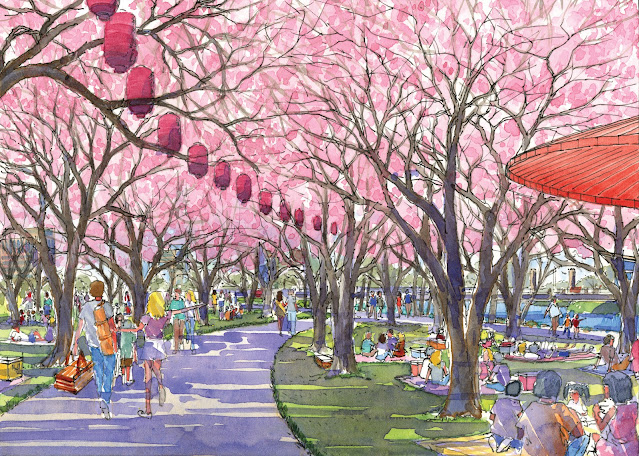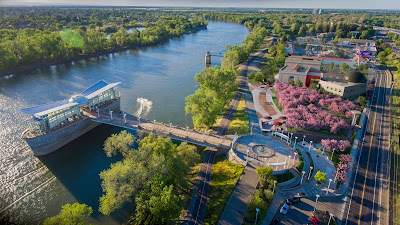
SacTree unveils plans for new grove overlooking Sacramento River at Matsui Park

|
| An artist's rendering shows what the Hanami Line will look like when the cherry tree grove is in full flower. (Courtesy Sacramento Tree Foundation) |
A special place to celebrate cherry blossom time is coming to Sacramento’s riverfront.
This week, the Sacramento Tree Foundation unveiled plans to transform a lawn overlooking the Sacramento River into a Hanami Line – a gathering place framed by rows of flowering cherry trees.
To be part of Robert T. Matsui Waterfront Park just north of downtown Sacramento, the grove will include an artistic walkway, grassy areas, benches and public art – a lovely setting for public gatherings and individual enjoyment.
The Hanami Line (pronounced hah-nuh-mee) is expected to open in 2023 with its first blooms next spring.
According to the foundation, “The Hanami Line will combine Sacramento’s love of trees with the rich cultural heritage of this region. In cities across the world, people celebrate the arrival of spring by gathering with loved ones under the cherry blossoms. In Japan, this tradition is known as hanami and draws thousands of families to picnic, play, and relax in its parks.”
Sacramento’s Hanami Line could become a spring destination for both residents and visitors. Besides cherry blossom time, the space also could be used for year-round recreation, community events and festivals.

|
|
The pink trees in this rendering show where the Hanami Line
will be installed near the Sacramento River.
|
Congresswoman Doris Matsui, honorary co-chair of the Hanami Line capital campaign, is the widow of the late Congressman Robert T. Matsui, the park’s namesake, and has been instrumental in making the Hanami Line a reality. She noted that Washington, D.C., also is famous for its cherry trees.
“We are a city of rivers and a city of trees, and the Hanami Line weaves both aspects of our civic character together,” she said. “It will salute Sacramento’s rich history and create a lasting connection with the cherry trees that bloom every year in our nation’s capital.”
This new grove will bring smiles for decades to come, noted Sacramento Tree Foundation executive director Jessica Sanders. “In the midst of all of the bad news over the past few years, let’s come together to build something beautiful for Sacramento – a place where we can connect with loved ones and find respite in nature just blocks away from downtown.”
Donations are still being accepted for this project. Visit sactree.org/hanami for more details.
Comments
0 comments have been posted.Sacramento Digs Gardening to your inbox.
Sites We Like
Garden Checklist for week of April 14
It's still not warm enough to transplant tomatoes directly in the ground, but we’re getting there.
* April is the last chance to plant citrus trees such as dwarf orange, lemon and kumquat. These trees also look good in landscaping and provide fresh fruit in winter.
* Smell orange blossoms? Feed citrus trees with a low dose of balanced fertilizer (such as 10-10-10) during bloom to help set fruit. Keep an eye out for ants.
* Apply slow-release fertilizer to the lawn.
* Thoroughly clean debris from the bottom of outdoor ponds or fountains.
* Spring brings a flush of rapid growth, and that means your garden needs nutrients. Fertilize shrubs and trees with a slow-release fertilizer. Or mulch with a 1-inch layer of compost.
* Azaleas and camellias looking a little yellow? If leaves are turning yellow between the veins, give them a boost with chelated iron.
* Trim dead flowers but not leaves from spring-flowering bulbs such as daffodils and tulips. Those leaves gather energy to create next year's flowers. Also, give the bulbs a fertilizer boost after bloom.
* Pinch chrysanthemums back to 12 inches for fall flowers. Cut old stems to the ground.
* Mulch around plants to conserve moisture and control weeds.
* From seed, plant beans, beets, cantaloupes, carrots, corn, cucumbers, melons, radishes and squash.
* Plant onion sets.
* In the flower garden, plant seeds for asters, cosmos, celosia, marigolds, salvia, sunflowers and zinnias.
* Transplant petunias, zinnias, geraniums and other summer bloomers.
* Plant perennials and dahlia tubers for summer bloom.
* Mid to late April is about the last chance to plant summer bulbs, such as gladiolus and tuberous begonias.
* Transplant lettuce seedlings. Choose varieties that mature quickly such as loose leaf.